
It says a lot about Sony’s marketing power when they can attach the name of one if its seminal movie franchises to one of its phones — James Bond — and have it stick. “The Bond Phone”, as the Xperia T has been called since its announcement, has made its way to Canada, and for the first time in as long as we can remember, a Sony phone is launching on multiple carriers.
Sony’s last two flagship devices, the solidly-built Xperia S and its LTE-capable companion, the Xperia ion, were results of a company in transition. Shedding its “Ericsson” legacy, the company has attempted to rebrand its mobile and entertainment divisions, integrate its popular PlayStation franchise into its smartphones and tablets, and provide a truly universal content platform in Music and Video Unlimited.
Now that the Xperia T is with us, the big question needs to be asked: with specs that finally equal the competition, can Sony’s vertically-integrated magic touch finally help push it into consumers’ hands? Let’s find out.
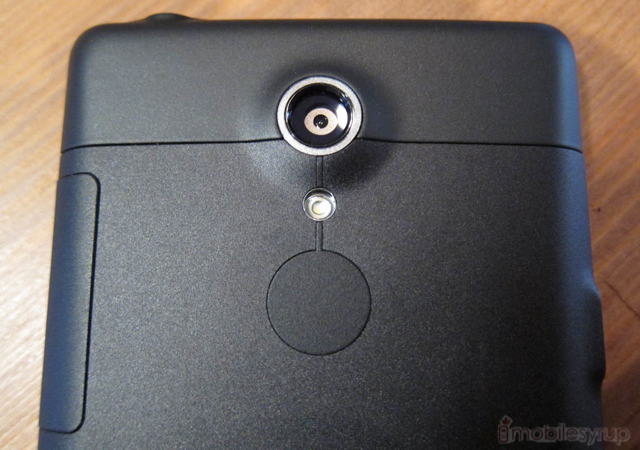
Specs:
– Android 4.0.4 with custom Sony layer
– 4.55-inch 1280×720 pixel LCD with Mobile Bravia Engine
– 1GB RAM, 16GB internal storage (expandable)
– 13MP back camera w/ Exmor R sensor, 1.3MP front camera
– 1080p video capture @ 30fps
– 1850mAh integrated battery (non-removable)
– WiFi (b/g/n), Bluetooth 3.1, A-GPS, NFC, WiFi Direct, Miracast
– 129.4 x 67.3 x 9.4 mm
– 148g
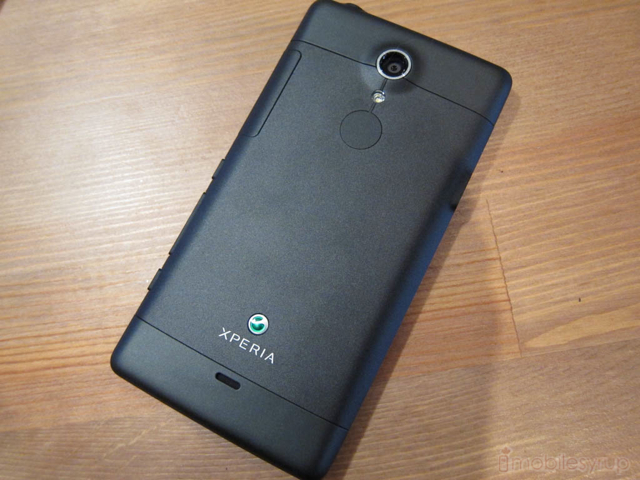
Design, Build Quality & Display
There is no question that the Xperia T is a well-built phone, but it is robust in a different way than its immediate predecessors. Whereas the Xperia S and, to a lesser extent the Xperia ion, were solid slabs of plastic and metal, the Xperia T harkens back to the svelte curves of the Xperia arc. Despite its 4.55-inch screen it has a relatively small footprint, coming in 4mm shorter and 1mm narrower than the ion, and this compactness can be felt right away.
It’s also quite well made, though we could do without the snap-off cover for the microSIM and microSD cards on the right hand side. In fact, nearly every important feature of the device is on the right hand side, placed somewhat differently to the competition. The power button is small, with good feedback, squarely in the middle of the phone’s length. Under it is a volume rocker, a placement which I grew to appreciate over time. While adjusting volume often required a shift of the phone in the hand, the placement of the rocker allows for zooming while taking photos. The hardware camera shutter, a fixture on Sony devices, is small but responsive.
The Xperia T’s front resembles many modern devices, if only because it is an attractive black slab. But its sloping chin and tasteful ‘Xperia’ logo speak more to its design lineage than anything else. Sony has done away with capacitive buttons in favour of Android’s on-screen variety, the decision is welcome. The phone curves slightly outwards, expanding slightly at each pole, and appears slim as a result. Though, at 9.4mm it won’t win any awards, I had no trouble tricking myself into believing the Xperia T was a thinner phone than it was.
The device’s screen is also quite good — better than the Xperia S and the ion — with only a small gap between the IPS display and the very responsive glass/digitizer combo. Unfortunately, like previous Sony devices, the Xperia T doesn’t have great viewing angles, though again it exhibits significantly better sideways visibility than its predecessors. Though this isn’t the best 720p display on the market, Sony has done an admirable job minimizing the screen’s bezel — and therefore the phone’s footprint — while maintaining excellent usability. Colours are deep and rich, contrast is extremely good, and whites are true. And thankfully, after years of omission, the Xperia T has an ambient light sensor, so no more manually adjusting brightness settings.
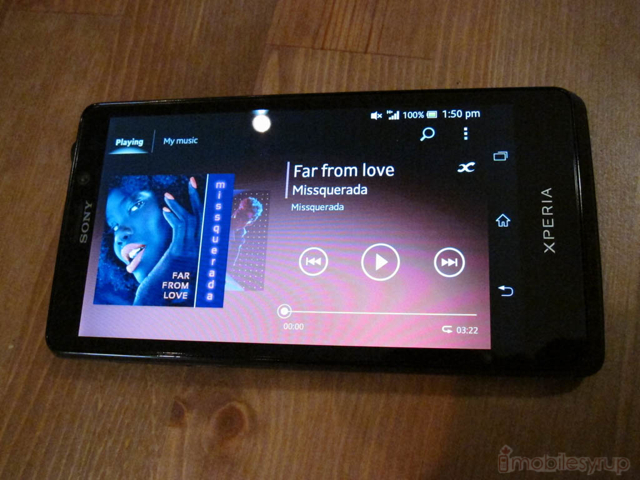
Performance & Software
The Xperia T runs the same software as the upgraded version of the Xperia S and ion. If you’ve used a Sony product in the last year, you are already well versed. Where the Xperia T differs is in the experience.
Thanks to the fast dual-core Snapdragon S4 processor, the Xperia T is the first Sony device that really stands up well to the competition at the time of its release. Though it runs Android 4.0.4, the handset felt consistently quick and I rarely missed the quad-core experience of the Nexus 4. That being said, though the Sony is indeed using a current-generation chip, that it runs Ice Cream Sandwich is a disappointment. The company is slated to release a Jelly Bean upgrade in Februrary 2013, but by that time Android 4.2 will have become the de facto software on Android and there will likely be another version available to the public. Sony has stayed true to its word to update many of its legacy phones, but the speed at which they are released pales next to Samsung and HTC.
What Sony gets right is in content consumption. From the gallery with preloaded James Bond assets to the gorgeous music player, Sony knows how to design superb-looking Android apps. Even the keyboard, which is often a bone of contention in custom OEM skins, is sublime, and includes accurate autocorrect along with a gliding feature for extra fast input.
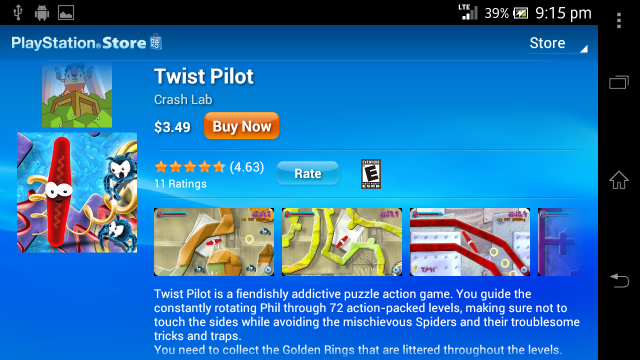
Sony has preloaded a number of its own apps, including a shortcut to PlayStation Mobile. I have no issue with the idea of PSM but there are games offered by Sony, such as Twist Pilot, that are more than three times the cost of the equivalent title on the Play Store. There is no incentive for users to purchase the game unless they cross-play with a PS Vita.
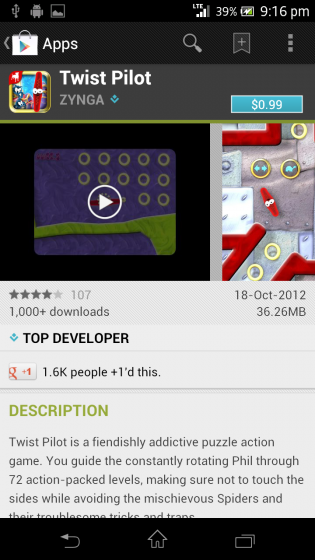
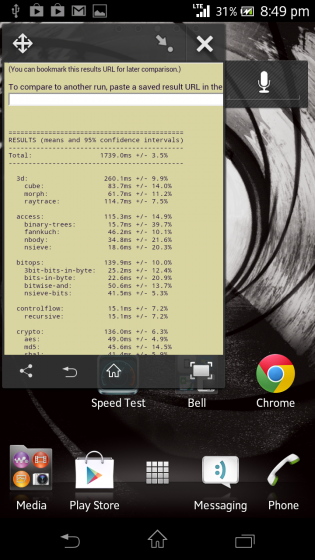
The Bell version of the device, which we reviewed, comes with Mobile TV included, and continues to improve as it matures. Quality over Bell’s LTE network was stellar, and the on-demand content, such as HBO’s Game of Thrones, is now worth paying for.
The phone’s overall performance, while not at the very top of the charts, was competitive with devices like the Samsung Galaxy S III and HTC One X. But with the Optimus G, Nexus 4 and Galaxy Note II offering quad-core benefits and decent battery life, the Xperia T fails to evoke the sense of awe that should come from a flagship smartphone.

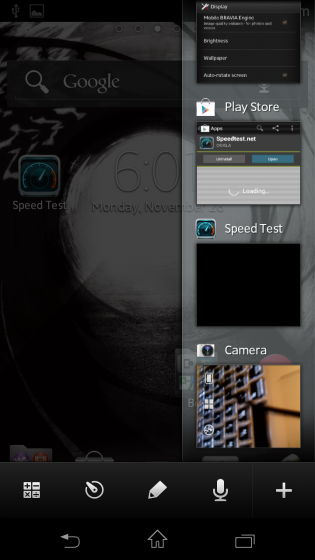
So it’s left up to Sony’s user experience to woo consumers, and thankfully they’ve done a fantastic job with that. Adapted from the company’s Xperia Tablet S, the Xperia T offers “Small Apps”, a series of small utilities that can be launched from the multitasking menu. By default, the phone comes with a calculator, timer, note taker and voice recorder. Sony has released a Small Apps SDK, too, and I downloaded a tiny browser and camera launcher that came in handy more than once. These apps act more like widgets, and can be moved around or overlaid on top of whatever you’re doing. More than convenient, they add to the Android experience, and don’t feel gimmicky.
Lastly, Sony has bundled its Music and Video Unlimited apps with the Xperia T. These are monthly subscription and a la carte services respectively, and while the former is available for all Android devices, their inclusion reinforces for whom the Xperia T is best: someone already entrenched in the Sony ecosystem.

Camera
Though the Xperia T comes with a 13MP camera, the photo quality captured by the tiny sensor is only slightly better than the equivalent 8MP sensor on devices like the iPhone 5 and Galaxy S III. Indeed, when compared to the 8.7MP shooter on the Nokia Lumia 920, the Xperia T falls short. Photos contained plenty of detail but emerged noisy, with muted colours.
The other issue with the camera was its shutter speed. Most modern cameras can continue shooting after the first frame, but the Xperia T stumbles slightly when shooting multiple shots quickly. The software tries to reassess the frame and determine the correct focus for the shot, but in doing so it limits the number of consecutive shots one can take. This is a minor quibble since the sleep-t0-shoot feature is alive and well, allowing you to capture photos in under one second when the phone is turned off.
Ultimately, the Xperia T provides one of the best photo-taking experiences on a smartphone today. Like the Lumia 920 and other Windows Phones, Sony has traditionally placed a high priority on responsive dual-step physical shutter buttons, and despite the small size the one on the Xperia T is fantastic to use. By default the app shoots 10MP photos at a 16:9 ratio, filling up the entire wide screen; it also defaults to Auto Scene mode, which attempts to pick the best presets for the situation. This usually worked quite well, but I preferred to take photos in manual mode at a 4:3 ratio.
I didn’t find the photo quality to be tangibly better than that of the 12MP Xperia S, but video quality, likely due to the improved processing capabilities of the SoC, is significantly better. Not only was 1080p video smooth and detailed, but I found it to be better than most phones in the same category.
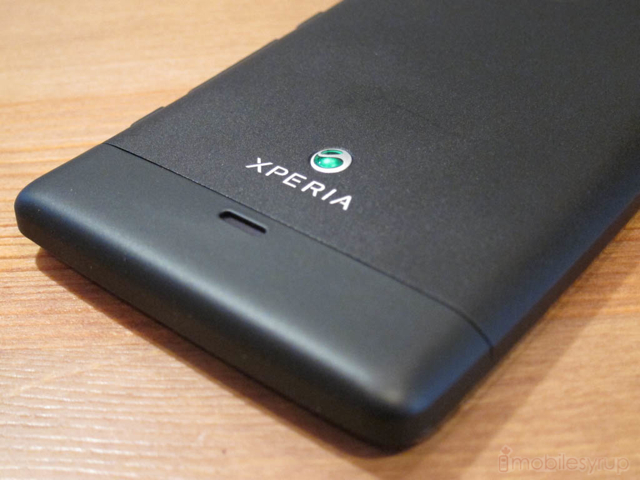
Battery Life
I expected Sony to ensure that the Xperia T lasted appreciably longer than its predecessors, and while I was happy to see it lasting almost a full day on a single charge, the phone’s longevity was still a point of contention.
For whatever reason, even with the latest-and-greatest in processor efficiency, and all the software improvements in Android 4.0.4, the Xperia T didn’t manage to outlast the Galaxy S III or HTC One X. Where it scored well was in standby mode, lasting three days or so on a single charge. With moderate use I was lucky to get nearly eight hours from the phone.
In our comprehensive battery tests, which involved playing a movie on loop at 50% brightness with the phone connected to the cellular network, the Xperia T managed just over five and a half hours, putting it right in the middle of our list. While Sony does include a number of power-saving features such as Extended Standby Mode, which turns off data traffic when the screen is off, I’d caution anyone in enabling this feature unless you are comfortable missing important notifications.
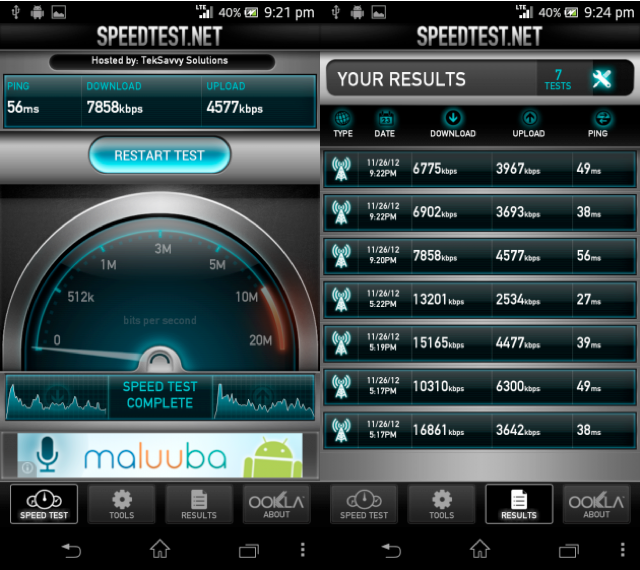
Network Speeds & Connectivity
The Xperia T is launching on a number of carriers, and we tested the Bell version on its LTE network. While speeds were noticeably faster than the carrier’s HSPA+ results, we were slightly disappointed in the results. Perhaps because we’re used to astronomical numbers on other devices, that the Xperia T didn’t broach 20Mbps down and 10Mbps up was a bit of a letdown. We didn’t notice a tangible difference in browsing load times or app downloads, but it was nonetheless below the industry standard.
This could be due to poor reception on the Xperia T’s part, as the phone often dropped down to HSPA+ when other Bell devices such as the HTC 8X maintained a relatively strong LTE signal. Call quality was consistently good, however, and we didn’t experience any issues with drops or poor reception.

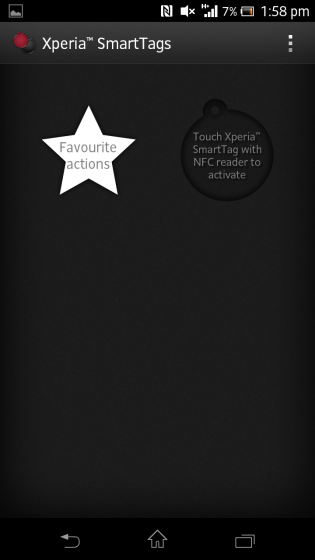
The Xperia T also comes with NFC support, and works together with the company’s SmartTags app to create robust actions from a single tap. For example, if you purchase a set of SmartTags, or any NFC-enabled tag for that matter, you can set the device to connect to a specific Bluetooth headset or play a specific song. It’s quite a comprehensive app and allows for multiple actions from different categories.
Then there’s Smart Connect, which attempts to outdo Motorola’s SMARTACTIONS. You can set the app to silence your phone when charging, or to start the music app when headphones are inserted. All the actions follow a When (device/time) / Do This (action) or At the End (action) workflow, so you can get quite imaginative with the whole combo. SmartTags and Smart Connect work independently — one requires NFC and one doesn’t — but can accomplish similar things.
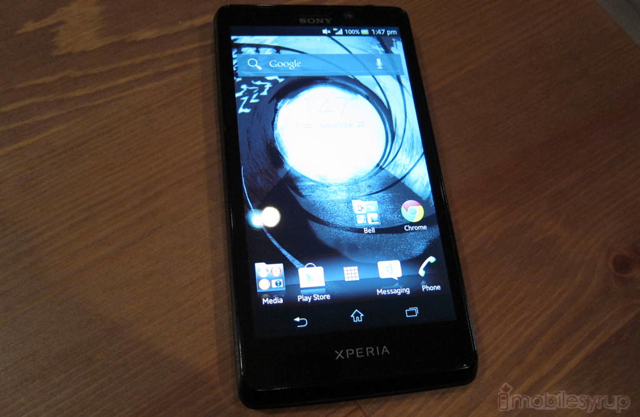
Conclusions
The Sony Xperia T is the first truly competitive Android smartphone from the manufacturer. While its performance and battery life cannot compete with many of the more expensive devices on the market, the Xperia T finds a nice compromise between size, speed and price. At $49.95 on Bell and $99.99 on Rogers with a contract, the device costs significantly less than many of its Android competitors.
What you get is a capable, attractive phone with a number of nice software touches, value-add apps that fall short of bloatware, and one of the most usable form factors on a larger device.
While the Bond branding and includes assets may get you in the door, Sony’s done a great job ensuring that, once inside, you want to stay for dinner.






